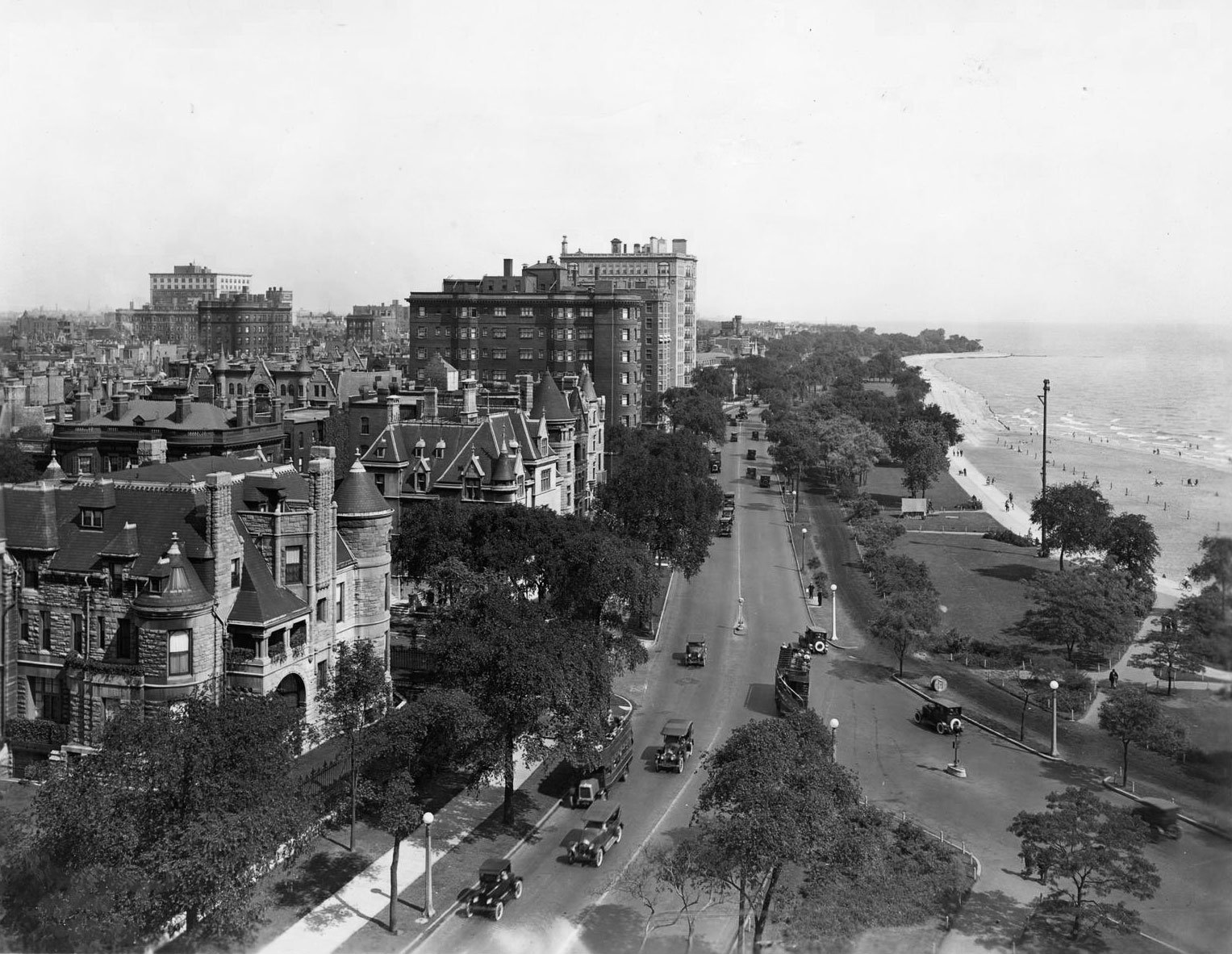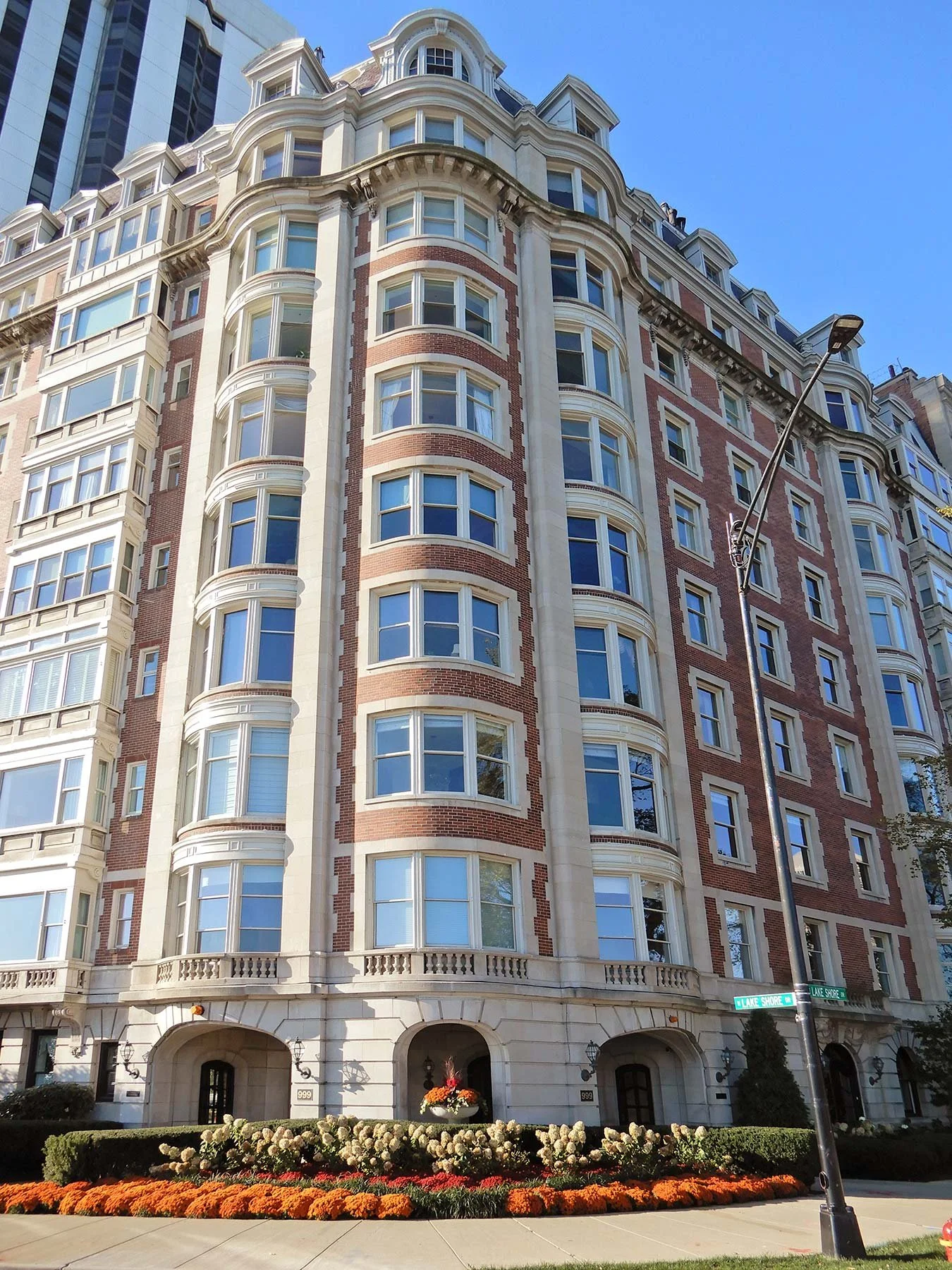View of DuSable Lake Shore Drive looking north from the John Hancock Center. Photo by Eric Allix Rogers.
I recently completed work on a major project—the Historic Properties Identification process for DuSable North Lake Shore Drive (NLSD). As required by historic preservation laws, thorough documentation must be undertaken when projects using federal or state funds could have visual or physical impacts on historic properties. Redefine the Drive, an ambitious initiative of the Illinois Department of Transportation and Chicago Department of Transportation, is preparing studies for much-needed repairs and improvements to the historic lakefront boulevard. Working with Quigg Engineering, Inc., and Civiltech Engineering, Inc., I led a talented team of historians that included Liz Patterson and Jean Follett to prepare a Section 106 Historic Properties Identification Report for DuSable North Lake Shore Drive, from Grand to Hollywood Avenue.
Lake Shore Drive looking north from Oak Street, ca. 1925. Newberry Library, CB&Q A-5-3 Record Group A-5 Box 64 Folder 346.
Architects Marshall & Fox designed the sumptuous 1912 apartment building at 999 NLSD. Photograph by Julia Bachrach.
I will be sharing some of our findings in a three-part Newberry Library virtual seminar called Learning from Lake Shore Drive on Wednesdays December 1st through 15th, 2021, from 6:00-7:30 p.m. The seminar will illuminate the history of Lincoln Park and NLSD, as well as many of the fabulous residential buildings that overlook the north lakefront. Read more about seminar registration at newberry.org.
The historical development of NLSD can be pretty confusing, especially because it includes so many stretches of roadway, some of which had various names over time. For this month’s blog, I’ll focus on a few of the early stretches and explain how the allure of the lakefront and NLSD attracted the development of fine nearby residences.
Plan of Lincoln Park by Olof Benson, Landscape Gardener and Superintendent, ca. 1880. Courtesy of Norman B. Leventhal Map & Education Center.
Plans for NLSD were first created in 1870, soon after management of Lincoln Park was transferred from the city’s Board of Public Works to the newly-established Lincoln Park Commission. The commissioners hired the park’s original designers, Swain Nelson (1828-1917) and Olof Benson (1836-1909), to extend Lincoln Park north to Diversey Parkway and south to North Avenue. Nelson & Benson envisioned a pleasure drive along the park’s lakefront edge. Although construction of this original stretch of NLSD was soon underway, the work didn’t always progress easily. For example, in 1871, so many cows wandered onto the construction site that the commissioners gave Nelson and Benson special permission to charge bovine owners a $15 fee every time they had to impound an animal and wait for its owner to come and take it home. Despite the somewhat slow progress, the Lincoln Park Commissioners described the 40-foot-wide clay and gravel roadway as “one of the most attractive features of the park” in their 1871 Annual Report. (This oldest portion of Lake Shore Drive is part of the existing Cannon Drive roadbed.)
Old Lake Shore Drive (now part of the Lincoln Park Zoo parking lot in the roadbed of Cannon Drive), ca. 1885. Chicago Park District Records: Photographs, Special Collections, Chicago Public Lib
By the early 1870s, Nelson & Benson were working to extend NLSD south to Oak Street. The 200-foot-wide, three-quarter-mile-long boulevard improvement was completed in 1875. Although the private land just to the west was quite swampy and often referred to as an eyesore, the newly extended Drive and Lake Michigan frontage attracted wealthy families to the area. Most influential were hotelier and businessman Potter Palmer and his wife, Bertha Honoré Palmer, a respected civic and cultural leader. In 1882, the Palmers purchased a large amount of land extending west from NLSD between Burton Place and Banks Street.
View of Lake Shore Drive with Palmer Mansion on the left. Detroit Publishing Company Photograph Collection, ca. 1905, Library of Congress.
Potter and Bertha Palmer soon began planning a new mansion to overlook NLSD, as well as investment properties to the north and west. The Chicago Tribune reported that “a concerted movement will now be made by Mr. Palmer and the other property owners to fill up all of the depressions between State Street and Lake Shore Drive and lift this property into its rightful place, as the choicest kind of residence property, not surpassed by any in the city.” The Palmers built an enormous and fanciful home nicknamed “the castle,” where they often hosted lavish dinners and other social events. (The Palmers’ famous home remained a lakefront icon until 1950, when it was razed to make way for a high-rise at 1350-1360 N. Lake Shore Drive.)
Although Romanesque style residences were once quite prevalent along NLSD, only two remain—the Carl Heisen House (left) and Mason Starring House (right) at 1250 and 1254 NLSD. Photo by Julia Bachrach.
Soon after the Palmers moved into their mansion, other well-to-do Chicagoans built large, fashionable houses nearby. These include two Romanesque style residences of the 1890s—the Carl C. Heisen House by architect Frank Abbott at 1250 NLSD and the Mason Brayman Starring House, a Gustav Hallberg-designed structure at 1254 NLSD.
Holabird & Roche designed both of these single-family residences—the Aldis House on the left and Rockwell House on the right. Photos by Julia Bachrach.
Completed in 1911, Howard Van Doren Shaw’s 1130 NLSD was one of the area’s earliest co-operative buildings. Photo by Julia Bachrach.
Just north of the two Romanesques stand a pair of very different, but equally impressive, residences by architects Holabird & Roche. At 1258 NLSD is the spectacular 1895 Venetian Gothic style home of Arthur and Mary Aldis. Next door at 1260, Lawrence D. and Grace Madeline Rockwell’s stately 1911 Georgian style mansion fronts onto E. Goethe Street. During this period, luxury apartment buildings began to spring up nearby. Early extant examples include the handsome mid-rise at 1130 NLSD. Howard Van Shaw designed this building, with eight spacious, full-story units for the families of his brother, several friends, and himself.
As the Lincoln Park Commissioners were working on the Drive’s North Avenue to Oak Street extension in the mid-1870s, some Lake View residents began requesting that NLSD be expanded as far north as Devon Avenue. (Early on, this proposed extension was called North Shore Drive.) Although the commissioners supported the idea, when representatives of Lake View Township put the proposal up for public vote in 1876, the project wasn’t approved. Residents of the area just north of Belmont Avenue were very disappointed, so a decade later, they petitioned for a smaller-scale project—a lakefront roadway that would stretch between Belmont Avenue and Byron Street (now W. Sheridan Road).
Cross Section of Proposed Protection for Sheridan Road Blvd. Near Belmont Avenue, J. Richter Engineer, July 21, 1897. Chicago Park District Records: Drawings, Special Collections, Chicago Public Library.
Even though this project would be much more modest than the proposed extension to Devon Avenue, the effort would still require new landfill to widen the existing park and provide space for the new pleasure drive and its associated amenities. A breakwater with a sturdy seawall would also be needed to protect the greenspace and roadway from storm damage. As the commissioners were then in the midst of improving Lake View Avenue north of Diversey Parkway, they weren’t yet ready to pursue this project.
Sketch No. 2, Protection for Sea Wall, November 28, 1898. Chicago Park District Records: Drawings, Special Collections, Chicago Public Library.
Originally known as the Exmoor Flats, the Atelier was one of the early elevator apartment buildings that took advantage of the new extension of the Drive. Photo by Julia Bachrach.
After Lake View Township was annexed to Chicago in 1889, the Belmont Avenue area residents pushed strongly for the roadway extension project. In fact, they offered to pay a special assessment to fund this extension, a stretch of the Drive that runs from current-day W. Belmont Avenue to W. Sheridan Road. The commissioners agreed to the project the following year. By that time, the new stretch of Lake View Avenue between Diversey and Belmont had been completed. The proposed extension of the Drive would run north from there. (Now considered Inner Lake Shore Drive, this historic stretch of NLSD was, for a time, known as N. Sheridan Road.)
View of Shore Drive from the window of the Exmoor (630 W. Sheridan Road). Courtesy of Chicago History Museum, iCHi- 17819, ca. 1900.
Plan of Lincoln Park Extension, Chicago, by O.C. Simonds, 1911. Courtesy of United States Department of the Interior, National Park Service, Frederick Law Olmsted National Historic Site.
Completed in the late 1890s, the project included a 45-foot roadway with two parallel paths—one for bicycles, and the other for horses. It also provided a sidewalk for pedestrians, parkways, and rows of trees. During this period, some Lakeview developers began to take advantage of these new public amenities by erecting attractive multi-family dwellings with spacious apartments and fine views of the lake nearby. One early example was the Exmoor Flats (now called the Atelier) at 628-630 W. Sheridan Road. An advertisement that ran in the Chicago Tribune in 1900 touted the building’s large, seven-room units that featured “outside light in every room,” “marble and mosaic halls,” and “enameled bathrooms.”
In the early 1900s, after the Lincoln Park Commission underwent significant political reform, a new slate of commissioners pushed for another major project in the area—a new landfill extension of Lincoln Park that would stretch as far north as Cornelia Avenue. It would feature a boating harbor at the foot of Belmont Avenue, beaches, lawns, and playfields, and Picnic Island, an oblong landform east of what is now Diversey Harbor. At roughly 275 acres, this expansive project nearly doubled Lincoln Park’s size when it reached completion around 1915.
Each time the park and lakefront roadway underwent improvements, desirable new residential buildings sprang up nearby. Among the early luxury apartments near Belmont Harbor was the classically-inspired eight-story 3314 N. Lake Shore Drive designed by L.G. Hallberg & Co. architects. The 1916 building had enormous apartments with spectacular views of the lake, the most impressive of which belonged to its developer, Charles B. Smith, secretary of the Stewart-Warner Speedometer Corporation.
The elegant apartment building at 3314 NLSD originally had seven 18-room suites. Photo by Julia Bachrach.
With the prosperity of the 1920s came many other fine multi-family buildings with stunning lakefront views. The Depression ushered in a period of little residential development, however it was the time in which NLSD would be completely transformed. The New Deal provided millions of dollars of infrastructure improvements for Chicago, most notably, a modern high-speed NLSD boulevard with grade separations to accommodation commuters as well as park patrons. But that is a big story for another day.
















